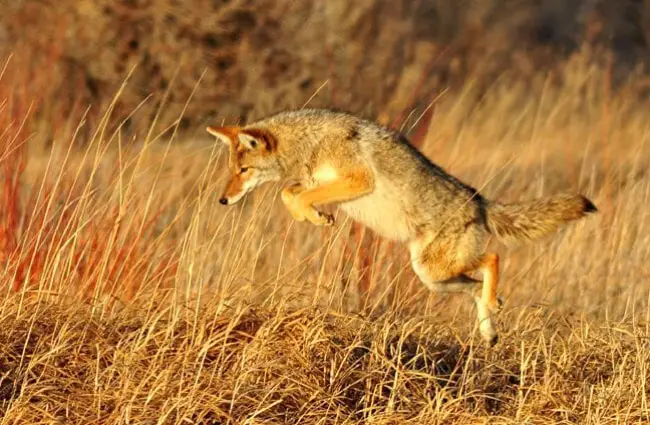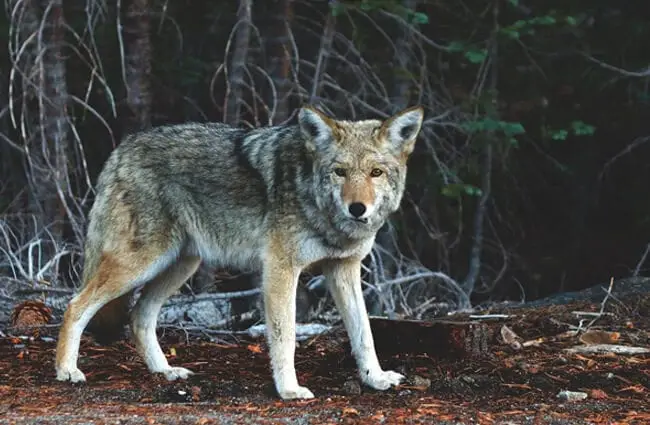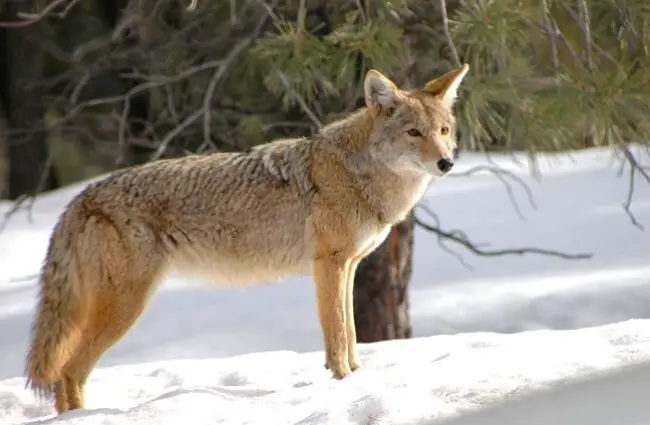The wilderness holds many secrets, but few creatures embody the spirit of adaptability and resilience quite like the Coyote. Often misunderstood, sometimes feared, and always fascinating, this iconic canid has not only survived but thrived across the North American continent, carving out a niche in nearly every ecosystem imaginable. From the arid deserts to bustling cityscapes, the Coyote’s story is one of remarkable evolutionary success, a testament to its intelligence, versatility, and sheer will to endure.
As a zoologist who has spent countless hours observing wildlife and then translating those observations into accessible knowledge, the Coyote stands out as a prime example of nature’s ingenuity. It is a creature that challenges our preconceptions about wild animals, constantly reminding us that the natural world is far more dynamic and interconnected than we often realize. Let us embark on a journey to uncover the many layers of the Coyote’s existence, from its ancient origins to its modern-day interactions with humans and the environment.

Unveiling the Coyote: A Master of Adaptation
The Coyote, scientifically known as Canis latrans, meaning “barking dog,” is a medium-sized member of the dog family, Canidae. It is a close relative of the domestic dog and the gray wolf, yet possesses a unique set of characteristics that distinguish it from its kin. Its physical appearance is often described as a lean, athletic build, perfectly suited for its active lifestyle.
Physical Characteristics and Identification
- Size: Coyotes typically weigh between 20 to 50 pounds (9 to 23 kg), with males generally being larger than females. They stand about 20 to 26 inches (50 to 66 cm) tall at the shoulder and measure 3 to 4.5 feet (0.9 to 1.4 m) from nose to tail tip.
- Coat: Their fur color varies significantly depending on their geographic location, ranging from grayish-brown to yellowish-gray, often with a reddish tint on the legs, ears, and muzzle. The throat and belly are usually lighter, a creamy white. A distinctive dark stripe often runs down the middle of their back, and their bushy tail typically has a black tip.
- Features: Coyotes possess pointed ears, a slender muzzle, and keen, intelligent eyes that are usually amber or light brown. Their long, bushy tail is often carried low, between their legs, especially when running or feeling threatened, a key differentiator from wolves who typically carry their tails higher.
The Coyote’s Domain: Habitat and Range
Perhaps one of the most astonishing aspects of the Coyote is its incredible adaptability to diverse environments. Originally a creature of the open plains and deserts of western North America, its range has expanded dramatically over the last century, now encompassing virtually all of North and Central America, from Alaska to Panama.
- Diverse Ecosystems: Coyotes thrive in an astonishing array of habitats, including:
- Forests: Deciduous, coniferous, and mixed forests.
- Grasslands and Prairies: Their historical stronghold, offering abundant prey.
- Deserts: Arid and semi-arid regions, showcasing their ability to conserve water.
- Mountains: Up to high elevations, demonstrating tolerance for cold and rugged terrain.
- Swamps and Wetlands: Adapting to watery environments.
- Agricultural Lands: Utilizing farms and fields for food and cover.
- Suburban and Urban Areas: A testament to their remarkable ability to coexist with human development, finding food and shelter in parks, green spaces, and even densely populated neighborhoods.
- Finding Coyotes in the Wild: For the aspiring animal lover, locating a Coyote requires patience and understanding of their habits. They are most active during dawn and dusk (crepuscular) but can be seen at any time, especially in less disturbed areas. Look for their tracks, which resemble those of a medium-sized dog but are typically more oval with distinct claw marks. Listen for their characteristic howls, yips, and barks, particularly at night. Areas with dense cover near open spaces, like the edge of a forest next to a meadow, or urban parks with natural vegetation, are good places to start.

The Omnivorous Opportunist: What’s on the Menu?
The Coyote’s diet is a prime example of its adaptability. It is a highly opportunistic omnivore, meaning it will eat almost anything available, a strategy that has been key to its widespread success.
- Primary Prey: Small mammals form the bulk of a Coyote’s diet. This includes:
- Rodents (mice, voles, gophers, rats)
- Rabbits and hares
- Ground squirrels
- Secondary Food Sources: Coyotes are not picky and will supplement their diet with a variety of other items:
- Birds: Especially ground-nesting species and their eggs.
- Insects: Grasshoppers, crickets, beetles.
- Reptiles and Amphibians: Lizards, snakes, frogs.
- Fruits and Vegetables: Berries, apples, watermelons, corn, and other seasonal produce.
- Carrion: Scavenging on dead animals, including deer, livestock, and roadkill.
- Human-Associated Foods: Pet food left outdoors, garbage, compost, and even fallen fruit from backyard trees.
- Hunting Strategies: Coyotes are skilled hunters, often employing a characteristic pounce to catch small prey. They can hunt alone or in small groups, particularly when targeting larger prey like deer fawns or sick/injured adult deer. Their keen senses of smell and hearing are crucial for locating food.

Life of a Coyote: Behavior and Reproduction
Coyote social structures and reproductive habits are finely tuned to their environment, allowing for efficient resource utilization and successful raising of young.
Social Structure and Behavior
- Social Dynamics: While often perceived as solitary, Coyotes exhibit a flexible social structure. They can live alone, in monogamous pairs, or in small family groups consisting of a breeding pair and their offspring from the current and sometimes previous years. Pack sizes are generally smaller than those of wolves, typically 3 to 6 individuals.
- Communication: Vocalizations are a cornerstone of Coyote communication. Their distinctive howls, yips, barks, and growls serve various purposes:
- Howls: Announce presence, locate pack members, or warn off rivals.
- Yips and Barks: Often associated with excitement, play, or alarm.
- Group Howls: Can create the illusion of a larger pack, a clever deterrent to potential threats.
- Activity Patterns: Coyotes are primarily crepuscular (active at dawn and dusk) and nocturnal, especially in areas with human activity. However, they can be seen during the day, particularly in undisturbed rural areas or during periods of high food demand.
Mating and Reproduction
Coyote reproduction is a seasonal affair, typically occurring in late winter to early spring, ensuring pups are born when resources are becoming more abundant.
- Mating Season: Breeding usually takes place from January to March. Coyotes are generally monogamous, with pairs often staying together for several years.
- Gestation and Birth: After a gestation period of approximately 60 to 63 days, a litter of 1 to 12 pups is born, with an average of 5 to 7. Litter size can vary significantly based on food availability and population density, with larger litters often seen when prey is abundant or populations are recovering from control efforts.
- Denning: Pups are born blind and helpless in a den, which can be a burrow dug by the parents, an enlarged badger hole, a hollow log, a rock crevice, or even a culvert. Both parents participate in raising the young.
- Pup Development:
- Pups open their eyes at about 10 to 14 days old.
- They begin to venture out of the den at 3 to 4 weeks.
- Weaning occurs around 5 to 7 weeks, after which they start consuming regurgitated food from their parents and solid food.
- By late summer or early fall, the pups are nearly full-grown and begin to disperse from their natal territory, though some may remain with the family group for longer.

The Coyote’s Journey: Evolution and Ecological Impact
The evolutionary history of the Coyote is a fascinating tale of survival and adaptation, deeply intertwined with the changing landscapes of North America. Its role in the ecosystem is complex and vital, influencing many other species.
Evolutionary History
Coyotes originated in North America during the Pliocene epoch, approximately 5 million years ago. They are believed to have evolved from a common ancestor shared with wolves and domestic dogs. Unlike their larger wolf relatives, who were more specialized predators of large ungulates, Coyotes evolved as generalists, capable of exploiting a wide range of food sources. This adaptability proved to be their greatest asset.
- The Pleistocene Era: During the Ice Ages, Coyotes coexisted with a diverse megafauna, including dire wolves and saber-toothed cats. Their smaller size and generalist diet likely allowed them to survive environmental shifts that led to the extinction of many larger predators.
- Post-Wolf Era: The widespread eradication of gray wolves in many parts of North America during the 19th and 20th centuries created an ecological vacuum. Coyotes, with their remarkable ability to reproduce quickly and adapt to human-altered landscapes, rapidly filled this void, expanding their range eastward and northward. This phenomenon is often referred to as “mesopredator release.”
Contribution to the Ecosystem and Interaction with Other Animals
Coyotes play a crucial role in maintaining the health and balance of their ecosystems.
- Population Control: As predators, they help regulate populations of small mammals, preventing overgrazing and the spread of disease. They also prey on deer fawns, contributing to deer herd health by removing weaker individuals.
- Scavengers: By consuming carrion, Coyotes help clean up the environment and recycle nutrients.
- Interspecies Interactions:
- Competition: Coyotes compete with other mesopredators like foxes, bobcats, and even domestic dogs for food and territory.
- Cooperation: A fascinating example of interspecies cooperation is the Coyote-Badger relationship. Coyotes and badgers sometimes hunt together, with the Coyote chasing prey like ground squirrels into burrows where the badger can dig them out, or the badger flushing prey out for the Coyote.
- Predation: While primarily predators, Coyotes can occasionally become prey for larger carnivores like wolves, cougars, and bears, though these interactions are less common now due to the reduced range of these larger predators.

Coyotes and Us: Interaction and Coexistence
The increasing presence of Coyotes in human-dominated landscapes has led to both challenges and opportunities for coexistence. Understanding their behavior is key to minimizing conflicts.
Coyote’s Contribution to Human Culture
Coyotes hold a significant place in the folklore and mythology of many Indigenous North American cultures. They are often depicted as a “trickster” figure, embodying both wisdom and foolishness, creation and destruction. These stories reflect the Coyote’s intelligence, cunning, and adaptability, serving as moral lessons and explanations for the natural world. This cultural significance highlights a deep, historical connection between humans and Coyotes.
Interaction with Humans: Challenges and Solutions
As Coyotes move into suburban and urban areas, interactions with humans become more frequent. While generally shy, they can become habituated to human presence, leading to potential conflicts.
- What to do if you encounter a Coyote in the wild or urban areas:
- Do not run: Running can trigger a chase response.
- Make yourself large and loud: Wave your arms, shout, and make eye contact.
- Haze the Coyote: Throw small stones or sticks near it (not at it) to scare it away. Carry a whistle or air horn.
- Keep pets on a leash: Small pets can be seen as prey.
- Never feed Coyotes: This is the most critical rule. Feeding them, directly or indirectly, habituates them to humans and can lead to aggressive behavior.
- Report aggressive behavior: If a Coyote shows unusual boldness or aggression, contact local animal control or wildlife authorities.
- Preventing Conflicts:
- Secure garbage cans and compost bins.
- Do not leave pet food or water bowls outside, especially overnight.
- Supervise small children and pets outdoors, especially at dawn and dusk.
- Clear dense brush from around your property to reduce hiding spots.
- Install motion-activated lights or sprinklers.
Caring for Coyotes in Captivity (for Zookeepers)
Caring for Coyotes in a captive environment requires specialized knowledge and a deep understanding of their natural history to ensure their welfare.
- Essential Tasks:
- Enclosure Design: Provide spacious enclosures with natural substrates, climbing structures, hiding spots (dens), and water features. Strong, dig-proof fencing is paramount.
- Diet: Replicate a natural, varied diet. This includes whole prey items (rodents, rabbits, poultry), high-quality commercial carnivore diets, and occasional fruits/vegetables. Avoid processed human foods.
- Enrichment: Crucial for mental and physical well-being. This includes puzzle feeders, scent enrichment, novel objects, rotating toys, and opportunities for digging and exploring.
- Veterinary Care: Regular health checks, vaccinations, parasite control, and prompt treatment for any injuries or illnesses.
- Social Grouping: House compatible individuals, typically a breeding pair or small family group, mimicking their natural social structure.
- Observation: Daily monitoring of behavior, appetite, and physical condition to detect any signs of stress or illness.
- What to Avoid:
- Habituation: Minimize direct human interaction to prevent habituation, which can lead to stress or dangerous behavior.
- Inadequate Space: Small or barren enclosures can lead to stereotypic behaviors and poor welfare.
- Monotonous Diet: A lack of dietary variety can lead to nutritional deficiencies and boredom.
- Lack of Enrichment: Without mental and physical stimulation, Coyotes can become lethargic or develop behavioral issues.
- Inappropriate Social Grouping: Forcing incompatible individuals together can lead to aggression and injury.
- Direct Hand-Feeding: This can reinforce undesirable behaviors and is unsafe.

Fascinating Facts About the Coyote
The Coyote is a creature full of surprises. Here is a list of intriguing facts that highlight its unique attributes:
- Ghost Dog: Coyotes are sometimes called “ghost dogs” due to their elusive nature and ability to disappear silently into the landscape.
- Speed Demons: They can reach speeds of up to 40 miles per hour (64 km/h) over short distances, making them formidable pursuers of prey.
- Impressive Jumpers: Coyotes can jump fences up to 6 feet (1.8 meters) high, and even higher with a running start.
- Vocal Virtuosos: A single Coyote can produce a complex chorus of howls, yips, and barks, making it sound like multiple animals. This “chorus effect” is a clever way to make their numbers seem larger than they are.
- Super Survivors: They are one of the few large carnivores whose populations have actually increased and expanded their range in the face of human development.
- Dietary Flexibility: While primarily carnivores, their diet can be up to 40% plant matter, showcasing their incredible dietary plasticity.
- Hybridization: In some eastern regions of North America, Coyotes have hybridized with wolves and domestic dogs, resulting in larger, more wolf-like “coywolves” or “eastern coyotes” that possess a blend of traits from their parent species.
- Keen Senses: Coyotes have exceptional senses of smell and hearing, allowing them to detect prey and predators from great distances, even underground.
- Intelligent Hunters: They are known to use various hunting tactics, including stalking, ambushing, and even working cooperatively with badgers.
- Family Values: Coyote parents are dedicated caregivers, with both mother and father contributing to raising and protecting their pups.
Conclusion: The Enduring Spirit of the Coyote
The Coyote is more than just another wild animal; it is a symbol of resilience, adaptability, and the enduring power of nature. From its ancient evolutionary roots to its modern-day presence in our backyards, this remarkable canid continues to captivate and challenge us. Its ability to thrive in an ever-changing world offers valuable lessons about ecological balance and the intricate dance between wildlife and human civilization.
For students, animal lovers, aspiring zoologists, and anyone who shares a landscape with these intelligent creatures, understanding the Coyote is not just about accumulating facts. It is about fostering respect, promoting coexistence, and appreciating the wild spirit that continues to howl across the North American continent. The Coyote’s story is far from over, and its future, like ours, depends on our ability to learn, adapt, and share the world with all its incredible inhabitants.

![Red Angus Closeup of a beautiful Red Angus cowPhoto by: U.S. Department of Agriculture [pubic domain]https://creativecommons.org/licenses/by/2.0/](https://animals.net/wp-content/uploads/2020/03/Red-Angus-4-238x178.jpg)




![Red Angus Closeup of a beautiful Red Angus cowPhoto by: U.S. Department of Agriculture [pubic domain]https://creativecommons.org/licenses/by/2.0/](https://animals.net/wp-content/uploads/2020/03/Red-Angus-4-100x75.jpg)

